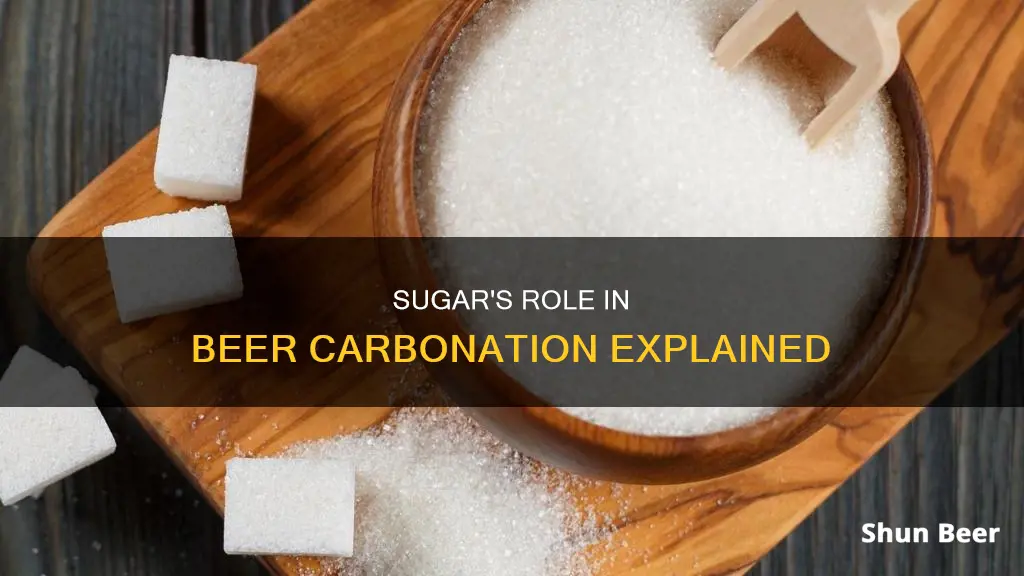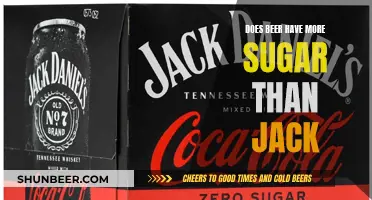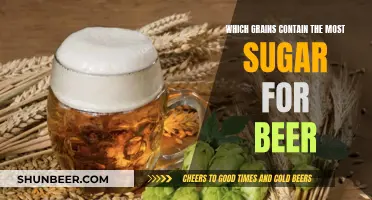
Carbonation is an important feature of beer. It gives the beverage its mouthfeel, perceived body, and heavily influences the way that hop and malt aromas are delivered to your nose. The level of carbonation depends on the style of beer being brewed. For example, real English ales are served with almost no added carbonation, while German Weizen is highly carbonated. Carbonation occurs naturally in beer since yeast produces carbon dioxide along with alcohol when it eats sugar. To achieve the desired level of carbonation, brewers add a specific amount of sugar just before bottling. This process is called bottle conditioning or refermentation, where the CO2 produced from the re-fermentation in the beer bottle is absorbed into the beer, creating carbonation.
What You'll Learn

The amount of sugar added determines the level of carbonation
The amount of sugar added to beer during the carbonation process will determine the level of carbonation in the final product. Carbonation is an important feature of beer, as it influences the mouthfeel, perceived body, and the way that hop and malt aromas are delivered to the drinker's nose. It is also critical to the beer's appearance and head retention.
The level of carbonation in beer is typically expressed in volumes of CO2. One volume of CO2 is the amount of gas dissolved into the same volume of liquid. For example, one volume would be a litre of CO2 dissolved in a litre of beer, or a gallon of CO2 dissolved in a gallon of beer. Most beers are served with a carbonation level of around 2-3 volumes, though there are exceptions. For instance, real English ales are served with almost no added carbonation, while German Weizen beers are highly carbonated.
The amount of sugar added during carbonation will determine the level of carbonation in the beer. When using corn sugar, the following quantities are recommended: 0.5 ounces per gallon for low carbonation (suitable for dry stouts and English ales), 0.9 ounces per gallon for medium carbonation (American ales and porters), and 1.5 ounces per gallon for high carbonation (German weissbiers and Belgian blonds). It's important to note that the type of sugar used will also affect the level of carbonation, as different sugars have slightly different amounts of fermentables relative to their weight. For example, when using dextrose, you will need to add 15% more sugar by weight compared to using sucrose.
To ensure the desired level of carbonation is achieved, it is crucial to calculate the correct amount of sugar needed based on the volume of beer, the desired level of carbonation, and the type of sugar used. Online calculators and brewing software can be helpful tools for determining the precise amount of sugar required.
By adjusting the amount of sugar added during carbonation, brewers can control the level of carbonation in their beer, thereby influencing the sensory experience and overall quality of the final product.
Beer and Sugar: What's the Connection?
You may want to see also

Carbonation methods: bottle conditioning vs force carbonation
Carbonation is an important feature of beer – it adds mouthfeel, perceived body, and heavily influences the way that hop and malt aromas are delivered to your nose. It is also critical to the beer's appearance and head retention.
Bottle Conditioning
Bottle conditioning is the process of naturally carbonating beer by adding a priming solution (water + some type of sugar) to the flat beer immediately before bottling to initiate a "re-fermentation" in the bottle. The CO2 produced from the re-fermentation in the beer bottle is absorbed into the beer, creating carbonation. The amount of carbonation in the finished beer can be controlled by adjusting the amount of priming sugar in the priming solution.
Bottle conditioning also has an effect on the flavour and aroma of the beer due to the presence of active yeast in the bottle. The yeast in the bottle is able to reabsorb or process byproducts from fermentation, eventually rounding out or mellowing the flavours. It can also extend the shelf life of beer by delaying the staling effects of oxidation.
Force Carbonation
Force carbonation is a quicker and more controlled method of carbonation in which pressurised CO2 is forced into the well-contained beer. The fastest results can be achieved when the beer in the keg is at a cold temperature. This will let the CO2 diffuse into the beer more efficiently and at a faster rate. The most accurate and easiest method for force carbonating is often referred to as the "set it and forget it method." Select your refrigerator temperature and your desired carbonation rate, set your CO2 regulator to that pressure, and wait 5-10 days for the beer to carbonate.
Comparison
Bottle conditioning is a natural process that allows the brewer to control the amount of carbonation in the beer. It also has an effect on the flavour and aroma of the beer and can extend its shelf life. On the other hand, force carbonation is a quicker and more controlled method that can be achieved in a couple of days. It is also easier to clean and fill kegs, and this process takes only a fraction of the time it would take to bottle the same amount of beer.
Stella Beer: Sugar Content and Nutritional Facts
You may want to see also

How to calculate the amount of priming sugar needed
The amount of priming sugar needed to carbonate beer depends on several factors, including the desired level of carbonation, the type of sugar used, the volume of beer, and the temperature of the beer. Here is a step-by-step guide on how to calculate and use priming sugar for carbonating beer:
Step 1: Determine the Desired Carbonation Level
Before calculating the amount of priming sugar, decide on the desired carbonation level for your beer. Carbonation levels are typically expressed in volumes of CO2, with most beers falling in the 2-3 volume range. Different beer styles call for different carbonation levels. For example, a dry stout or English ale is typically carbonated at a lower level, while a German weissbier or Belgian blond style is highly carbonated.
Step 2: Choose the Type of Sugar
Common types of sugar used for priming include corn sugar (dextrose), table sugar (sucrose), or dry malt extract (DME). The choice of sugar will impact the amount needed, as different sugars have varying carbonation potentials.
Step 3: Calculate the Amount of Sugar
Use a priming sugar calculator to determine the precise amount of sugar required. These calculators consider the volume of your beer, the type of sugar, the desired carbonation level, and the fermentation temperature. The calculator will estimate how much sugar is needed to achieve your desired carbonation level.
Step 4: Prepare the Priming Sugar Solution
Before bottling, prepare a priming sugar solution by mixing the calculated amount of sugar with a small amount of distilled water. Boil the solution for about ten minutes to sanitise it and then allow it to cool.
Step 5: Mix the Solution with the Beer
Transfer your beer into a separate container, leaving a small amount of space at the top. Gently stir in the priming sugar solution for at least 30 seconds to ensure it is thoroughly mixed.
Step 6: Bottle and Store
Bottle the primed beer and store the bottles at room temperature for around two to three weeks. During this time, the yeast will process the sugar and produce carbon dioxide, naturally carbonating your beer.
It is important to ensure that fermentation is complete before bottling to avoid over-carbonation or bottle explosions. You can test this by checking the final gravity (FG) of the beer a couple of days before bottling. If the FG measurement is the same for two consecutive days, fermentation is complete.
Nonalcoholic Beer: Sugar Content and Health Benefits Explored
You may want to see also

The role of temperature in carbonation
The solubility of carbon dioxide in beer increases non-linearly as the temperature decreases. This means that lowering the temperature of the beer will result in a greater amount of carbon dioxide being dissolved in it. This is an important consideration when calculating the volumes of carbon dioxide required for carbonation, as the finished beverage's temperature will impact the residual carbon dioxide in the solution. This is one of the main reasons why beers may become over-carbonated.
The ideal temperature range for bottle conditioning beer is between 68-80°F (20-27°C). If the bottles are struggling to carbonate, it could be due to the temperature being too low. Moving the bottles to a slightly warmer location can help resolve this issue. Additionally, it is recommended to store the bottles off cold cellar floors, as these can be deceptively colder than the ambient temperature.
Temperature also plays a crucial role in the tasting experience of beer. It can significantly influence the flavour, aroma, carbonation levels, and mouthfeel. Different beer styles have optimal serving temperatures, which enhance specific characteristics and ensure a more pleasant drinking experience. For example, lighter beers like lagers and pilsners are typically served colder, around 38-45°F (3-7°C), while darker and more robust beers, such as stouts and porters, are served slightly warmer, between 50-55°F (10-13°C).
Beer and Blood Sugar: What's the Connection?
You may want to see also

The importance of carbonation in the beer's taste and smell
Carbonation is an essential aspect of beer, significantly influencing its taste, smell, and overall character. The level of carbonation, achieved through different methods, plays a pivotal role in the beer's mouthfeel, aroma, flavour, and even its appearance.
Firstly, carbonation directly impacts the mouthfeel of beer. The bubbles created by carbonation enhance the texture and make the beer more palatable and refreshing. A well-carbonated beer encourages drinkers to take another sip, making it more enjoyable. The level of carbonation can vary the mouthfeel from slick to explosive.
Secondly, carbonation aids in delivering the aromas of hops and malt to the nose. It helps gather and intensify these aromas, making them more noticeable. A beer with higher carbonation can accentuate delicate aromas, while lower carbonation might be preferable for bolder, more complex flavours. Carbonation also contributes to the overall flavour intensity of the beer by creating carbonic acid, which lowers the beer's pH and adds a subtle tangy note.
Additionally, carbonation affects the beer's appearance and head retention. A beer with adequate carbonation will have a finer head and smaller bubbles, enhancing its visual appeal.
The process of carbonation also influences the beer's flavour and aroma. Natural carbonation, achieved through bottle conditioning, involves a secondary fermentation where yeast consumes added sugar. This process can develop new flavours and add depth and character to the beer, especially when using wild yeast or unique sugar sources like fruit or honey.
Overall, carbonation is a key factor in the taste and smell of beer, impacting mouthfeel, aroma, flavour, and appearance. Brewers can manipulate carbonation levels to enhance the drinking experience and showcase the desired characteristics of their beer.
Stout Beer Sugar Content: What You Need to Know
You may want to see also
Frequently asked questions
Sugar is added to beer just before bottling to produce carbonation. The amount of carbonation depends on the amount of sugar added. The sugar is consumed by the yeast in the beer, which then produces carbon dioxide.
Many types of sugar can be used to carbonate beer, including corn sugar, table sugar, and dry malt extract.
The amount of sugar needed depends on the desired level of carbonation. For low carbonation, 0.5 ounces of corn sugar per gallon is sufficient, while for medium carbonation, 0.9 ounces per gallon is needed, and for high carbonation, 1.5 ounces per gallon is required.







